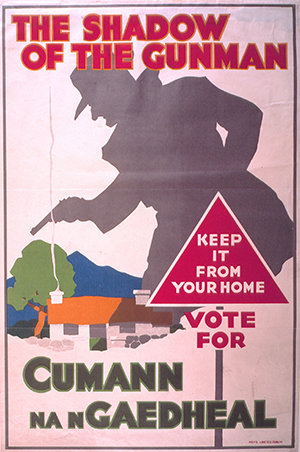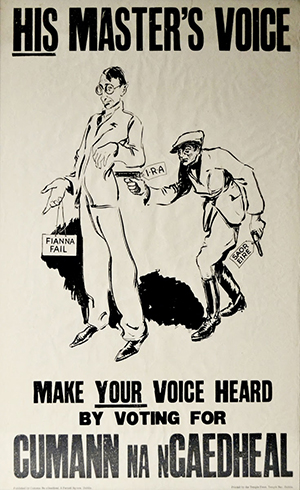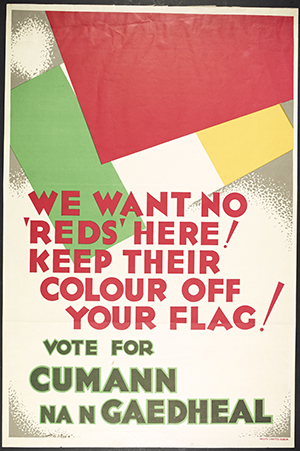PARALLELS: ‘The shadow of the gunman’ in 1932 and 2020
Published in Features, Issue 3 (May/June 2020), Volume 28Themes in Irish politics that have recurred over nine decades.
By James McNaney
 ‘Sinn Fein is not a normal political party.’ When Leo Varadkar said this during the recent general election campaign, he did not mean that Sinn Féin is unconventional but expressed fears over the party’s links to the IRA. Members of Fine Gael and Fianna Fáil asked whether Sinn Féin politicians made their own decisions or whether there were not some shadowy figures in West Belfast secretly pulling the strings.
‘Sinn Fein is not a normal political party.’ When Leo Varadkar said this during the recent general election campaign, he did not mean that Sinn Féin is unconventional but expressed fears over the party’s links to the IRA. Members of Fine Gael and Fianna Fáil asked whether Sinn Féin politicians made their own decisions or whether there were not some shadowy figures in West Belfast secretly pulling the strings.
The claim that your opponent is taking orders from secretive gunmen has an 88-year-old pedigree in Irish politics. Leo Varadkar and others were repeating, with surprising accuracy, the fears that surrounded the February 1932 general election. During that campaign, Cumann na nGaedheal attempted to counter the rise of Fianna Fáil by claiming that their opponents were really controlled by the IRA and were seeking to overthrow the legitimate government of Ireland. The parallels between the elections of 1932 and 2020 are more than coincidental; they reflect themes in Irish politics that have recurred over nine decades.
The context of fear
The 1932 election was the most contentious and significant contest in the short history of the Irish Free State. Cumann na nGaedheal’s decade of governance was under threat. The government’s record was challenged not only on the well-remembered constitutional issues of ties to the British Empire but also on the lack of housing, social security and employment in the Irish Free State. The conservative Cumann na nGaedheal had proved unable to adequately respond to the global economic crisis of the early 1930s, and faced a better-organised opponent with a clearer message. Tensions ratcheted up further in 1931 with the Public Safety Act, a draconian amendment to the Free State constitution, designed to counter a rise in IRA activity.
 This already febrile atmosphere was intensified further by the legacy of the Civil War. The political and personal conflicts that had divided Ireland in 1922–3 were still unresolved in 1932. Fianna Fáil had taken the oath of allegiance in 1927 but campaigned on a platform of rejecting parts of the Anglo-Irish Treaty. Cumann na nGaedheal still defended the treaty and the Free State that it had created.
This already febrile atmosphere was intensified further by the legacy of the Civil War. The political and personal conflicts that had divided Ireland in 1922–3 were still unresolved in 1932. Fianna Fáil had taken the oath of allegiance in 1927 but campaigned on a platform of rejecting parts of the Anglo-Irish Treaty. Cumann na nGaedheal still defended the treaty and the Free State that it had created.
Even more significant were the bitter personal divisions generated by the Civil War. Like all civil wars, Ireland’s had pitted communities against one another, and the ceasefire did not equate to forgiveness for the violence and destruction unleashed during the conflict. Moreover, the final months had seen waves of executions and atrocities by both sides which proved particularly difficult to forget. Treatyites would never forgive de Valera for not accepting the Treaty; Republicans would never forgive the Treatyites for failing to secure a republic.
In 1932, then, Cumann na nGaedheal faced an enemy whom they genuinely hated and who had the very real potential to unseat them. This mixture of resentment and fear created the dramatic campaign of that year.
Evoking the shadow
Desmond Fitzgerald did not hold back when giving his opinion of Fianna Fáil’s true intentions:
‘Mr de Valera has made it perfectly clear that he does not recognise the government elected by the Irish people. He aims at the overthrowing of the Irish people, not by majority rule, but by arms.’
Fitzgerald was not the only Cumann na nGaedheal politician who spoke in these terms. Revd Canon Barrett, speaking on an election platform, let the crowd know that ‘while that armed conspiracy [IRA] against the state existed it was not safe to change government’.
Cumann na nGaedheal’s message was unequivocal: a vote for Fianna Fáil was a vote for the gunman. This was seen most clearly in their election propaganda. An advert in 4 February’s Irish Independent told readers that ‘Fianna Fáil don’t want peace. They want all the votes they can beg, borrow or entice—TO GET THEIR REVENGE’. A famous election poster of 1932 makes literal the title of Seán O’Casey’s play, with a shadowy gunman displayed leaning over an idyllic Irish cottage. Viewers are implored to ‘Keep it from your home’.
 Some of these warnings went beyond the Civil War. Many Cumann na nGaedheal candidates warned that Fianna Fáil was a front for a quasi-Bolshevik communist conspiracy. The emergence of some far-left voices within the IRA, such as the group Saor Éire, allowed this ‘red scare’ to gain some traction. Another election poster shows a red field obscuring the tricolour, with the message ‘We want no “reds” here! Keep their colour off your flag!’ W.T. Cosgrave summarised his party’s motivation: ‘We are against Communism. We will not submit to either Russianism or Communism.’ Local concerns were tied into the imagery and imagination of worldwide politics in January and February 1932. The propaganda of Cumann na nGaedheal relied upon public knowledge and fear of left-wing revolutions around the world. When campaigners had to sketch out what Fianna Fáil’s Irish bolshevism would look like, however, the fantasies sounded more local and quotidian. In early February Ernest Blythe warned that ‘under a Fianna Fáil government’ IRA members ‘could do whatever they like’—including ‘lording it over their neighbours’. This was the politics of local land dispute and GAA board wrangling, not of State capture and class conflict.
Some of these warnings went beyond the Civil War. Many Cumann na nGaedheal candidates warned that Fianna Fáil was a front for a quasi-Bolshevik communist conspiracy. The emergence of some far-left voices within the IRA, such as the group Saor Éire, allowed this ‘red scare’ to gain some traction. Another election poster shows a red field obscuring the tricolour, with the message ‘We want no “reds” here! Keep their colour off your flag!’ W.T. Cosgrave summarised his party’s motivation: ‘We are against Communism. We will not submit to either Russianism or Communism.’ Local concerns were tied into the imagery and imagination of worldwide politics in January and February 1932. The propaganda of Cumann na nGaedheal relied upon public knowledge and fear of left-wing revolutions around the world. When campaigners had to sketch out what Fianna Fáil’s Irish bolshevism would look like, however, the fantasies sounded more local and quotidian. In early February Ernest Blythe warned that ‘under a Fianna Fáil government’ IRA members ‘could do whatever they like’—including ‘lording it over their neighbours’. This was the politics of local land dispute and GAA board wrangling, not of State capture and class conflict.
The actual relationship between Fianna Fáil and the IRA, and the IRA and its own left wing, was more contentious. The IRA agreed to support Fianna Fáil’s election campaign because it saw it as the least bad option available. De Valera himself made some nods, figuratively and literally, to IRA members during the campaign but stopped short of supporting the organisation outright. His policy of prisoner release was also an attempt to paint his opponents as authoritarians. Much of the rank-and-file membership of the IRA, meanwhile, was greatly at odds with the socialist radicalism of Peader O’Donnell and Saor Éire.
The ‘red scare’ and the ‘shadow of the gunman’ failed as election strategies. As members of Fianna Fáil argued during the election, the real issues facing Ireland were those of poverty and under-development. De Valera’s message of a better future proved more enticing for voters than Cosgrave’s prophecy of Bolshevik gunmen overthrowing ‘Ireland’s Kerensky’.
A hollow scare?
The attempt by Cumann na nGaedheal to label their opponents as dangerous revolutionaries, and to create fears over secret societies, was fatally undermined by the governing party’s own revolutionary legacy. The leading members of Cumann na nGaedheal had all been involved in the political and military sides of the revolution. Many of them had also been influential members of the IRB, as secretive and undemocratic an organisation as Irish politics had produced. The manifest double standards at play here, however sincerely meant, were fatal to the Irish right’s election chances.
The interpersonal dynamics of 1932’s bitter campaign remain fascinating. The arguments and accusations of that election were all made within a revolutionary generation, albeit one bitterly divided by the Civil War. The events being debated had happened a little over ten years earlier, well within the living memory of the electorate. Fianna Fáil’s leaders and members were former comrades of Cumann na nGaedheal. The argument was not over whether revolutionary violence had ever been justified but when it had ceased to be so. Mark Knirck points out that much of Cumann na nGaedheal’s messaging revolved around a claim that they were the true inheritors of 1916 and 1918. The Irish right in the 1930s celebrated the revolution while at the same time attempting to consign it to history.
The election of 1932 displayed certain themes that would recur over the following century. Most evocative is the real, or imagined, influence of secretive societies in Irish politics. The influential IRB Supreme Council of the revolutionary period created a lasting fear in subsequent generations, not least among former IRB members. Those who had seen up close how much influence a secret society could possess were also people liable to overstate the role of a new secret society. There was, therefore, a degree to which Cumann na nGaedheal could never trust Fianna Fáil because of what both parties had been involved in ten years earlier.
Subsequent dampening of emotions
It took another few years for the fever pitch of Irish elections to dampen down. The election of 1933 was similarly emotional, but with some subtle changes from a year earlier. The IRA was faced with the emerging Army Comrades Association, a right-wing movement famed for their eponymous outfits and the European fascist movements they echoed—the Blueshirts. Election meetings in 1933 occasionally involved clashes between the two semi-recognised organisations. Neither Fianna Fáil nor Cumann na nGaedheal fully embraced or resisted their respective associations with these groups.
Irish politics cooled somewhat in the later 1930s, as economic circumstances eased and the wilder fantasies of the Irish right and left proved unfounded. As Cumann na nGaedheal re-emerged as Fine Gael in the early 1930s, the leader of the para-fascist Blueshirts, Eoin O’Duffy, was sidelined, along with the threat of Irish fascism. Fianna Fáil’s manifestly unrevolutionary politics removed the political oxygen required for a reactionary movement to flourish.
The ‘red scare’ was also discredited by the events of the later 1930s and ’40s. De Valera’s government would go on to outlaw the IRA, and even to imprison and execute members of it. One could no longer argue that Fianna Fáil were the puppets of an organisation that they were actively trying to destroy. Whatever the morality of de Valera’s policy, it marked an undeniable end to his party’s ties to revolutionary violence.
The IRA evolved, or mutated, throughout the rest of the century, and the campaign of the Provisional IRA has left deep scars north and south of the border. As long as this more recent past remains unresolved and unconfronted, Irish elections will continue to echo the high drama and extreme emotions of January and February 1932.
James McNaney is a history Ph.D student at Queen’s University, Belfast.
FURTHER READING
Knirck, Afterimage of the revolution: Cumann na nGaedheal and Irish politics, 1922–1932 (Wisconsin, 2014).
McGarry, Eoin O’Duffy: a self-made hero (Oxford, 2005).
Regan, The Irish counter-revolution, 1921–1936: Treatyite politics and settlement in independent Ireland (Dublin, 1999).
















